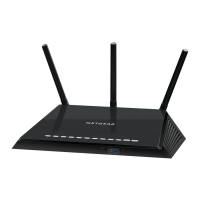
Do you have a question about the NETGEAR R6400 and is the answer not in the manual?
| Ethernet LAN | Yes |
|---|---|
| Cabling technology | 10/100/1000Base-T(X) |
| Networking standards | IEEE 802.11a, IEEE 802.11ac, IEEE 802.11b, IEEE 802.11g, IEEE 802.11n, IEEE 802.3, IEEE 802.3ab, IEEE 802.3u |
| Ethernet LAN data rates | 10, 100, 1000 Mbit/s |
| Ethernet LAN interface type | Gigabit Ethernet |
| Wi-Fi band | Dual-band (2.4 GHz / 5 GHz) |
| Wi-Fi standards | 802.11a, Wi-Fi 5 (802.11ac), 802.11b, 802.11g, Wi-Fi 4 (802.11n) |
| Top Wi-Fi standard | Wi-Fi 5 (802.11ac) |
| WLAN data transfer rate (max) | 1300 Mbit/s |
| USB version | 2.0/3.2 Gen 1 (3.1 Gen 1) |
| Rack mounting | No |
| Frequency band | 2.4 & 5 GHz |
| Bandwidth (first) | 2.4 GHz |
| Bandwidth (second) | 5 GHz |
| USB ports quantity | 2 |
| WLAN data transfer rates supported | 450, 1300 Mbit/s |
| USB 2.0 ports quantity | 1 |
| Ethernet LAN (RJ-45) ports | 4 |
| DHCP client | - |
| Security algorithms | WPA, WPA2-PSK, WPS |
| Product color | Black |
| Flash memory | 128 MB |
| Internal memory | 256 MB |
| Cables included | LAN (RJ-45) |
| Antennas quantity | 3 |
| Harmonized System (HS) code | 85176990 |
| Depth | 198.5 mm |
|---|---|
| Width | 191 mm |
| Height | 65 mm |
| Weight | 430 g |
Steps to unpack the router and identify package contents.
Guidelines for optimal placement of the router within the home for best wireless coverage.
Step-by-step instructions for connecting the router to the modem and power.
Methods to connect wirelessly using WPS or by finding the network name (SSID).
How to access the router's interface using a web browser for setup and configuration.
Instructions on how to log into the router's web interface using the default credentials.
Guide to using the wizard for automatic detection and setup of Internet connection.
Instructions for manually configuring the router's Internet connection settings.
Steps to set up IPv6 Internet connection types like Auto Detect, Auto Config, and tunnels.
Using QoS to assign priority to gaming and streaming video traffic.
Creating custom rules to prioritize specific applications or online games.
Prioritizing Internet video streaming traffic using downstream QoS.
Configuring parental controls to manage Internet access for specific devices or users.
Blocking specific websites by entering keywords or domain names.
Blocking specific Internet services or applications based on port numbers or protocols.
How to access connected USB storage devices from computers on the local network.
Detailed steps for performing Time Machine backups to a USB drive connected to the router.
Procedure to safely disconnect a USB drive from the router without data loss.
How to access USB drive files remotely via the Internet using Dynamic DNS.
Explanation of Dynamic DNS and how it enables remote network access using domain names.
Using the NETGEAR ReadyCLOUD service for remote access to USB storage devices.
Configuring the router as a DLNA media server to stream media to compatible players.
Streaming music from a USB drive using the router's iTunes server feature.
Downloading the ReadySHARE Printer utility software for Windows and Mac computers.
Connecting to and using a USB printer shared through the router.
Utilizing the scanning capabilities of a multifunction USB printer connected to the router.
Configuring essential wireless network settings like SSID and security.
Modifying wireless security settings, such as WPA/WPA2 encryption.
Creating a separate guest WiFi network for visitors, isolated from the main network.
Configuring the router in bridge mode to extend wireless network coverage.
Checking for and installing new firmware updates for the router.
Procedures for recovering a forgotten router administrative password using security questions.
Using the traffic meter to monitor and control Internet traffic volume and connection time.
Enabling and configuring remote access to the router's settings over the Internet.
Establishing a secure VPN connection for remote access to the network.
Using a VPN to access your home's Internet service when away from home.
Configuring port forwarding rules to allow incoming traffic to specific servers on the local network.
Configuring port triggering to dynamically open ports for specific applications.
Troubleshooting steps when the router can access the Internet but connected devices cannot.
Diagnosing router issues by observing the status and behavior of the LEDs.
Isolating and resolving problems related to wireless connection to the router.
Information on returning the router to its default factory settings using the reset button.
Detailed technical specifications of the R6400 router, including hardware and protocols.